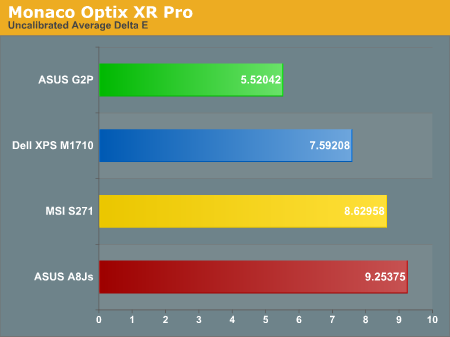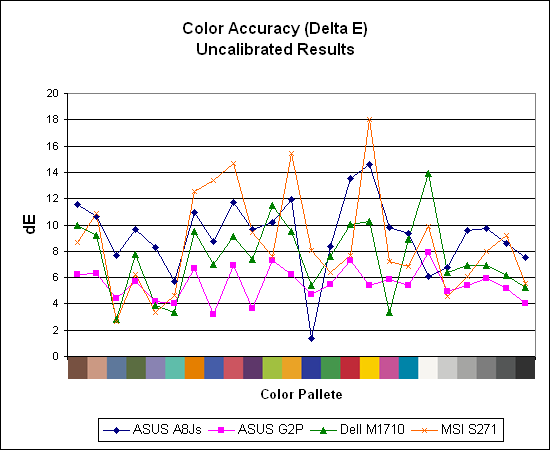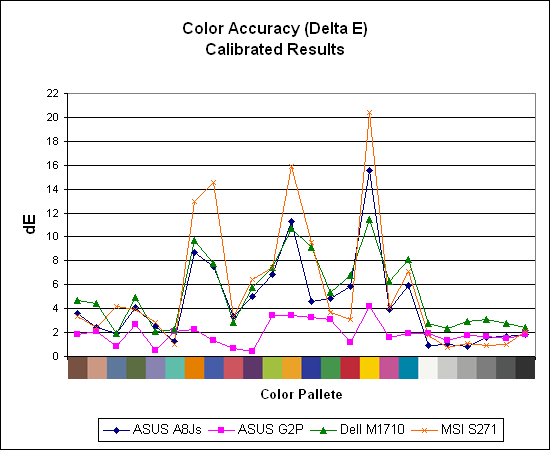Laptop LCD Roundup: Road Warriors Deserve Better
by Jarred Walton on May 22, 2007 5:00 AM EST- Posted in
- Displays
Color Accuracy
Other than adjusting the brightness level, there's not much that can be done with a laptop to change the default color values. The vast majority of users almost certainly use no color profile, so our uncalibrated color accuracy charts will be the most meaningful for them. Some people require more accurate colors, however, and while our instinct says that none of these displays can match the quality of the desktop LCD - even the best of them seems noticeably inferior to any of the desktop LCDs we've reviewed - the only way to prove or disprove this opinion is through actual objective testing.
During testing, Monaco Optix XR Pro sends 24 color patches to the display with the colorimeter measuring the resulting values. The difference between what is requested and what the LCD actually shows is known as Delta E, with lower values being better. Any score less than one is basically "perfect" - the naked eye is not going to be able to tell the difference - and scores less than 2.0 are very nearly perfect. Ideally, for accurate colors you would want all of the tested colors to have a Delta E of less than 1.0, but almost no one is likely to have problems with anything scoring below 2.0. From 2.0 to 4.0, most people still won't notice the slight inaccuracies in the color palette, but when comparing displays side by side differences may be apparent; multimedia professionals would prefer something better. Anything above 4.0 begins to represent a more significant deviance, and numerous scores above 6.0 will almost certainly be noticeable by just about anyone. Beware also of spikes in the Delta E charts, as a low average Delta E with several high spikes may not be as good in actual use as a display that offers a higher average Delta E but without the spikes.
Uncalibrated Results


Without any form of color correction, the color accuracy of all of these displays is poor. The ASUS G2P clearly generates the best overall score with a Delta E result of 5.52. However, there are still plenty of colors that fall above the 6.0 threshold, and even one that hits 8.0. As bad as that might seem, the other three displays are clearly worse. The XPS M1710 places second by a reasonable margin, but with several colors showing a Delta E of over 10.0 it's certainly nothing special. The MSI and ASUS A8Js both exhibit extremely poor color accuracy, with multiple large spikes on certain colors. We've seen some relatively poor uncalibrated results on desktop displays that have been turned around after calibration, so let's see if that's the case here.
Calibrated Results


If you were hoping for a turnaround after calibration, the above charts are probably pretty disappointing. As we've mentioned several times already, the ASUS G2P is far and away the best LCD out of the laptops we've used, and the calibrated color results bear this fact out. By no means are the results perfect, but with an average Delta E of 1.95 it at least comes relatively close, and only one color actually falls above the 4.0 threshold.
The other three laptops all get lower average Delta E scores after calibration, but they all have very similar curves with certain colors that simply cannot be accurately displayed. Yellows and blues in particular seem to present problems for many laptops, and there are a few colors that actually got worse after calibration! The backlighting used on a display can have a very large impact on the color accuracy, and we would venture to guess that most laptops are using similar low-power lamps that don't cover a lot of the standard NTSC color gamut. For anyone that's serious about doing image editing work on a laptop, consider this a warning that you will want to get a separate desktop LCD if possible in order to get a better representation of colors.
Other than adjusting the brightness level, there's not much that can be done with a laptop to change the default color values. The vast majority of users almost certainly use no color profile, so our uncalibrated color accuracy charts will be the most meaningful for them. Some people require more accurate colors, however, and while our instinct says that none of these displays can match the quality of the desktop LCD - even the best of them seems noticeably inferior to any of the desktop LCDs we've reviewed - the only way to prove or disprove this opinion is through actual objective testing.
During testing, Monaco Optix XR Pro sends 24 color patches to the display with the colorimeter measuring the resulting values. The difference between what is requested and what the LCD actually shows is known as Delta E, with lower values being better. Any score less than one is basically "perfect" - the naked eye is not going to be able to tell the difference - and scores less than 2.0 are very nearly perfect. Ideally, for accurate colors you would want all of the tested colors to have a Delta E of less than 1.0, but almost no one is likely to have problems with anything scoring below 2.0. From 2.0 to 4.0, most people still won't notice the slight inaccuracies in the color palette, but when comparing displays side by side differences may be apparent; multimedia professionals would prefer something better. Anything above 4.0 begins to represent a more significant deviance, and numerous scores above 6.0 will almost certainly be noticeable by just about anyone. Beware also of spikes in the Delta E charts, as a low average Delta E with several high spikes may not be as good in actual use as a display that offers a higher average Delta E but without the spikes.
Uncalibrated Results


Without any form of color correction, the color accuracy of all of these displays is poor. The ASUS G2P clearly generates the best overall score with a Delta E result of 5.52. However, there are still plenty of colors that fall above the 6.0 threshold, and even one that hits 8.0. As bad as that might seem, the other three displays are clearly worse. The XPS M1710 places second by a reasonable margin, but with several colors showing a Delta E of over 10.0 it's certainly nothing special. The MSI and ASUS A8Js both exhibit extremely poor color accuracy, with multiple large spikes on certain colors. We've seen some relatively poor uncalibrated results on desktop displays that have been turned around after calibration, so let's see if that's the case here.
Calibrated Results


If you were hoping for a turnaround after calibration, the above charts are probably pretty disappointing. As we've mentioned several times already, the ASUS G2P is far and away the best LCD out of the laptops we've used, and the calibrated color results bear this fact out. By no means are the results perfect, but with an average Delta E of 1.95 it at least comes relatively close, and only one color actually falls above the 4.0 threshold.
The other three laptops all get lower average Delta E scores after calibration, but they all have very similar curves with certain colors that simply cannot be accurately displayed. Yellows and blues in particular seem to present problems for many laptops, and there are a few colors that actually got worse after calibration! The backlighting used on a display can have a very large impact on the color accuracy, and we would venture to guess that most laptops are using similar low-power lamps that don't cover a lot of the standard NTSC color gamut. For anyone that's serious about doing image editing work on a laptop, consider this a warning that you will want to get a separate desktop LCD if possible in order to get a better representation of colors.










55 Comments
View All Comments
Hulk - Tuesday, May 22, 2007 - link
You guys always find the unexpolored areas to investigate. Great job!I have also always wondered why laptop displays have seemingly stalled in comparision to desktops. I would gladly sacrifice a little battery life for a high quality desktop-like display.
rqle - Tuesday, May 22, 2007 - link
Yup. Reviewing display from anandtech is great. Kudos on the viewing angle and response time. uniquely presented. ++mongo lloyd - Tuesday, May 22, 2007 - link
Not really. Behardware has been doing the same thing for quite a while.skyyspam - Tuesday, May 22, 2007 - link
I don't know why I haven't seen a laptop LCD comparison yet...but this has been very informative, and I only hope that Anandtech continues to evaluate laptop displays in the future.On the subject of laptop displays, how come I can't find a 17" stand-alone LCD panel that does 1920x1200? 24" is great and all, but sheesh--I don't need a screen to be that big. The 17" size is perfect for my eyes' resolving power.
Johnmcl7 - Tuesday, May 22, 2007 - link
One aspect that doesn't seem to have been given much discussion is resolution, one thing that irritates me about desktop TFTs is the low resolution compared to laptop monitors. You can have 1920x1200 on a 15.4 inch laptop display but you need to go up to 23 inches on a desktop display to reach that resolution.John
corduroygt - Tuesday, May 22, 2007 - link
I believe that display quality goes down as dpi (resolution relative to the screen size) goes up, and that's why the XPS did so poorly while the G2P did well. For example, compare two 15.4" notebooks one with the 1280x800 res and the other with the 1680x1050, and you'd see the difference. Similarly, compare the A8Js with another asus that has a 14.1 screen with 1280x800, and the lower resolution panel will have much better results. It's harder to get light through when you have more transistors for some reason. Also I have an A8Js and it's funny you did not mention the regular sand grain pattern you can see very easily when you have a white background, which irritates me much more than any of the issues in this article. You should definitely research the correlation between dpi and screen performance, and this might also explain why desktop monitors fare way better, and large lcd tv's are the best when it comes to display quality.Johnmcl7 - Tuesday, May 22, 2007 - link
Sorry, I didn't realise I had to consult you for my own opinion on TFT monitors.I have no need to research this because my choice is high resolution, I have used laptops and desktop TFTs for years - my WUXGA monitors do not suffer from 'grain' and I prefer having the higher resolution to give me more working space. A 1280x800 screen, even if it's the highest quality ever made is still useless to me because there's so little I can fit on screen whereas the 1920x1200 monitors actually let me get on with what I want to do.
If you don't like that, fair enough but given their existence in the laptop market clearly I'm not on my own in wanting a higher resolution - we should have the choice for our own preferences.
John
JarredWalton - Tuesday, May 22, 2007 - link
I agree that it would definitely be nice if people have more choice available -- both in desktops as well as laptops. However, he may be correct that higher DPI LCDs result in lower overall quality in other areas. Unfortunately, since no one manufacturers anything like that for the desktop so far all we have is speculation.I personally prefer a slightly lower DPI, but that's mostly because my vision isn't that great. I still use a 30" desktop LCD, because I really like the high resolution, but the 24" LCDs are a bit easier on my eyes. Regardless, we will try to bring up this topic with some of the display manufacturers to get their input.
DerekWilson - Wednesday, May 23, 2007 - link
I suppose this is where I interject the fact that high dpi effectively reduces aliasing without the need of graphical tricks (like antialiasing).The smaller each pixel, the less we will be able to see the stairstep pattern created by non-horizontal and non-vertical straight lines.
For those interested in the signal processing theory behind this, more dots per inch (dpi) translates to a higher sample rate in converting the continuous representation of a 3d world into a digital representaion suitable for display. Higher sample rates can more accurately represent higher frequency data -- which in images appears as high contrast edges.
Currently, aliasing is hidden using good game design techiques (avoid lots of high contrast edges), antialiasing (which increases the sample rate for each pixel and chooses pixel color based on more of the surfaces a single pixel covers), and low pass filtering (blurring the entire image slightly can reduce aliasing, but this is a low quality technique).
Sufficiently high DPI would eliminate the need for all of these techniques and really increase the quality of graphics on the desktop.
I would venture to guess that Jarred prefers lower dpi more because of the fact that operating systems interfaces don't currenlty scale well with dpi. High resolution shouldn't make things smaller, it should make things more detailed -- and it is the operating systems job to handle this in the majority of cases. modern operating systems fail at this.
some games do this better -- in games where controls, text, etc. take up the same ammount of screen space no matter what resolution is selected effectively fudge on handling dpi correctly -- that is, things aren't built on a fixed number of pixels but on a fixed portion of the physical display.
I'm not currently aware of games that do things "right" when it comes to dpi scaling -- that is that contorls and text would have a fixed size no matter what resolution or what size display is being used. This is how things should be done everywhere when it comes to graphical user interfaces. The application should be aware of how many pixels are in one inch, and it should be able to scale on screen controls and text to include more or fewer pixels to provide very consistent UI. This result in something like 18pt font always being 1/4 inch tall no matter what monitor and resolutoin combination are being used. (this also makes zooming in and out take on a meaningful role in the ui).
Doesn't that just seem like the right way to do it in the first place? Oh well... it's apparenlty too complicated :-/
But wow, I got off topic a bit ... If user interfaces scaled with dpi, we would all always perfer higher dpi, because higher dpi would directly translate into higher quality images consisting of higher frequency data giving us less aliasing and smoother images without blurring or subsampling.
high dpi is good -- current operating system, application, and game design are lacking in that they don't always (the exceptions are usually in graphics desing, publishing, and engineering software) make use of dpi data to present a consistent user interface. this turns resolution into "something that makes things smaller" when this is not something it should do at all.
ok, i'll stop now :-)
Deusfaux - Tuesday, May 22, 2007 - link
Where does one get this software you guys have used in LCD articles - especially for calibration of colors?Or perhaps there is a free equivalent? If the improvement is that substantial going from out-of-the-box to calibrated I'd certainly like to explore doing so on my 3007's